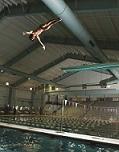
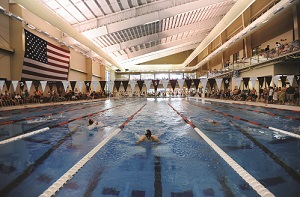
But as more sports tourism officials around the country recognize the long-term benefits of developing relationships with local swimming and diving clubs, natatorium operators and convention and visitors bureaus, they’re bringing in high-profile events that boost their community’s aquatics profile.
“Swimming is one of the core sports that we focus on,” says Ryan Vaughn, president of the Indiana Sports Commission. “We’ve always had a strong swimming community, and we have the most famous building in the history of the sport with the IU [Indiana University] Natatorium.”
Indianapolis, in fact, has become a Midwest aquatics hub, welcoming such high-profile events as the 2015 USA Diving Winter National Championships last December and the 2016 YMCA Long Course National Championships this July.
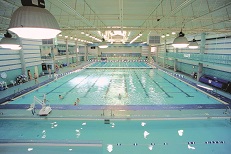
Below are details about eight destinations for swimming and diving (and synchronized swimming and water polo, too). Each offers state-of-the-art facilities with their own individual twists. But none of them would be as successful were it not for strong public-private partnerships and a common desire on the part of all stakeholders to make these destinations true swimming communities. In addition, each destination has something specific to help bring in the athletes and their families.
Renovations to Help Boost Synchronized Diving Events
The biggest indoor swimming facility in the United States is The IU Natatorium in Indianapolis, Indiana, with ample seating on both sides of the pool for 4,700. Located on the campus of Indiana University-Purdue University Indianapolis and built in 1982 for $20 million, the venue hosts state, regional, national and international events, as well as provides aquatic programming to IUPUI and the surrounding communities.
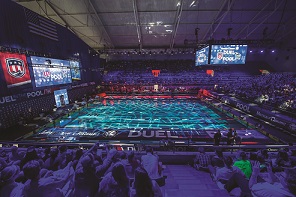
The natatorium features two 50-meter pools and a 17-foot diving well (which doubles as a 25-yard pool), with four 1-meter and four 3-meter boards, plus five diving platforms of 1, 3, 5, 7.5 and 10 meters. The IU Natatorium welcomes more than 100,000 swimmers and spectators every year, including Mutual of Omaha’s Duel in the Pool last December, which featured members of Team USA competing against Europe’s best swimmers.
Upcoming events include the 2016 USA Diving Olympic Team Trials in June and the 2017 NCAA Women’s Water Polo Championships. “The facility is a community asset,” Vaughn says. “But it’s also good to have younger kids see those larger events and get motivated by them.”
Multiple Venues for Double the Hosting Capabilities
Home to two major aquatic facilities, Raleigh, North Carolina, hosts both state and national events. The 72,000-square-foot Triangle Aquatic Center offers a 50-meter competition pool, a 25-yard program pool and an instructional pool, plus spectator seating for up to 1,000.
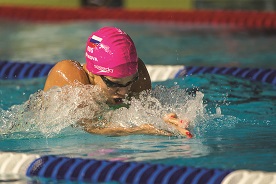
The National Black Heritage Championship Swim Meet mentioned previously will be held at the Triangle Aquatic Center through at least 2018. Last May, almost 900 swimmers participated, according to Jason Philbeck, assistant director of the Greater Raleigh Sports Alliance.
Raleigh’s other swimming facility is the publicly-owned Pullen Aquatic Center, which hosts several large-scale competitions in its 50-meter-by-25-yard pool. The venue is home to the annual NCHSAA State Diving Championships each February, and it also hosted the swimming competition of the 2015 Powerade State Games of North Carolina in June.
Taking on the Aquatics Side of a Multi-Sport Event
The USA Masters Games — a new biennial event modeled on the Olympics and developed to celebrate adult competition — will make its debut in Greensboro, North Carolina, this July. In addition to “Nationals-level” competitions in more than 20 sports, the USA Masters Games will feature opening and closing ceremonies, a Games Village and plenty of aquatics events.
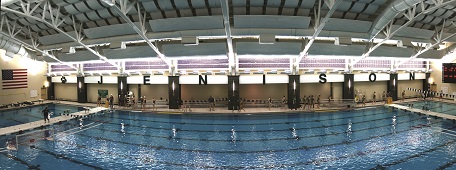
It’s a natural fit, says Amy Scott, director of marketing for the Greensboro Convention & Visitors Bureau. The facility — which is known locally as the GAC and includes a 50-meter competition pool, a 25-yard diving well and another 25-yard pool for warm-ups/cool-downs — hosted the U.S. Masters Swimming Spring National Championship in 2012 and will do so again this April.
In preparation for the Masters Games and other events, the north end of the pool deck inside the aquatic center has been expanded by 12 feet to provide more room for team seating and awards ceremonies, says Dee Mittman, sports sales manager for the CVB.
The Greensboro Aquatic Center also will host the 2016 NCAA Division III Swimming and Diving Championships in March and the 2016 YMCA Short Course National Championships in April.
Masters Synchro (and More) in Michigan
Speaking of U.S. Masters competitions, Grand Rapids, Michigan, hosted the 2015 U.S. Masters Synchronized Swimming Championships in October — the first-ever U.S. Masters Synchro event to be held in Michigan.
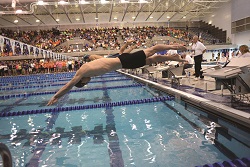
Held at the Jenison High School Aquatics Center, with seating for 800, the event attracted more than 267 participants ranging in age from 21 to 86, plus hundreds of spectators. Jenison High is one of the few facilities in the area with a 50-meter pool, two movable bulkheads and four diving boards (two 1-meter and two 3-meter).
Other aquatics facilities include the Venema Aquatic Center at Calvin College, which features a 50-meter pool with a moveable bulkhead, 1- and 3-meter diving boards and seating for 500 spectators, as well as the 25-yard pool in the Ford Fieldhouse Natatorium at Grand Rapids Community College.
The plan, Schlagel says, is to bring in more national events, such NCAA meets and USA Diving and USA Water Polo competitions.
With Multiple Venues, Water Sports Win
In Brown Deer, Wisconsin, about 12 miles north of Milwaukee, the Walter Schroeder Aquatic Center has served southeastern Wisconsin and the upper-Midwest as a premier competitive venue since its opening in 1979. It also is one of only two indoor 50-meter pools in Wisconsin that can host large-scale events, and the only one in the region to offer 10-meter diving platforms. As a result, the center has hosted NCAA championships in all three divisions, USA Swimming and USA Diving national and junior championships, plus many other events.
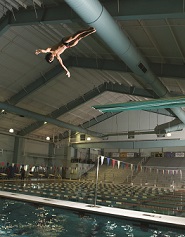
“Our pool is still relevant, and it’s still an important facility for the state and the region,” says David Anderson, director of competitive programs for the Schroeder Center.
A series of repairs and renovations have breathed new life into the facility, which hosts an annual regional Speedo “A+” age group and senior meet for elite club swimmers, as well as U.S. Under Water Hockey Nationals and Wisconsin Swimming and YMCA state meets.
According to Marissa Werner, sports and entertainment sales manager for VISIT Milwaukee, the city’s convention and visitor bureau is exploring ways for Milwaukee to become more involved with the Schroeder Center and bring in more regional and national events.
One Successful Facility and Another on the Way
Lubbock, Texas, will soon have another swimming facility to complement the Pete Ragus Aquatic Center. Owned and operated by the Lubbock Independent School District, that facility originally opened in 1997 and has since undergone two renovations and hosted everything from the 2011 USA Diving Spring Junior West National Championships to USA Swimming regional meets and the University Interscholastic League’s high school swimming and diving state championships.
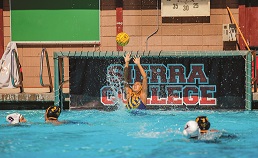
Swimming and Diving Under the Sun
While all of the other destinations covered up to this point have natatoriums, the major competitive aquatics venue in the Placer Valley region of Northern California — which includes the cities of Roseville, Rocklin and Lincoln — is outdoors.
The Roseville Aquatics Complex features an Olympic-size competition pool named after former Olympic gold medalist Summer Sanders (who was born in Roseville). The facility will be busy over the next few years, hosting the 2016 Speedo Sectional Western Zones, the 2017 USA Swimming Western Zone Age Group Championships and the 2018 U.S. Masters Synchronized Swimming Championships.
Meanwhile, the pool at Sierra College in Rocklin is emerging as an ideal synchronized swimming venue. “It’s great for synchronized swimming, because the participants compete in the diving well, where it’s deeper, and they use the swimming pool for warm-ups,” says Kim Summers, sports marketing relationship manager for Placer Valley Tourism.
Summers also oversees the organization’s grant program, which recently provided funding toward a new regional pool at Del Oro High School in nearby Loomis. With deep-water specs friendly toward water polo and synchronized swimming, the pool will likely begin booking events this fall, according to Summers.
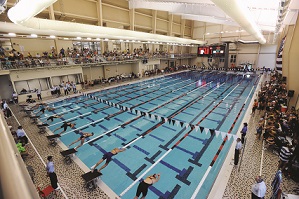
In Montgomery County, Virginia — which is comprised of two major towns, Christiansburg and Blacksburg — the Christiansburg Aquatic Center is a top priority. As a public-private venture with Virginia Tech University, the facility features a 50-meter pool and a diving tower with 5-, 7.5- and 10-meter platforms. It holds about 400 spectators and hosts national, regional, college and high school championship meets.
Other pools operated by local parks and recreation departments also attract events, but what most excites Montgomery County tourism director Lisa Bleakley these days is the region’s accelerated efforts to bring passenger rail service to the area, with potentially two passenger locations in Christiansburg — one close to the aquatic center.
“Once that train depot is in Christiansburg, it is going to be a catalyst for packaging so much of what we have in the area,” Bleakley says, adding that the combination of the town’s “robust bus system” with new rail options will complement each other and make getting around for athletes and their families more convenient than ever. Local leaders hope to have a rail system in place by 2020.
“We’re going to ride that train — pardon the pun — and work it into our plans regarding overall tourism,” Bleakley says.

